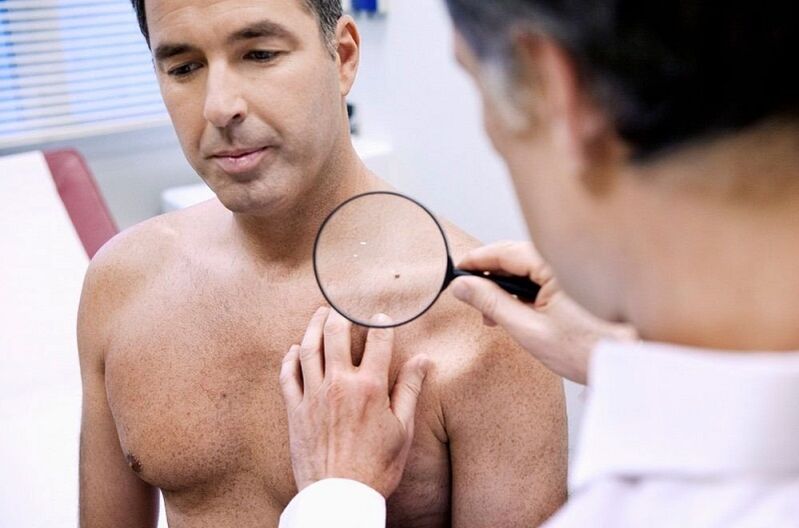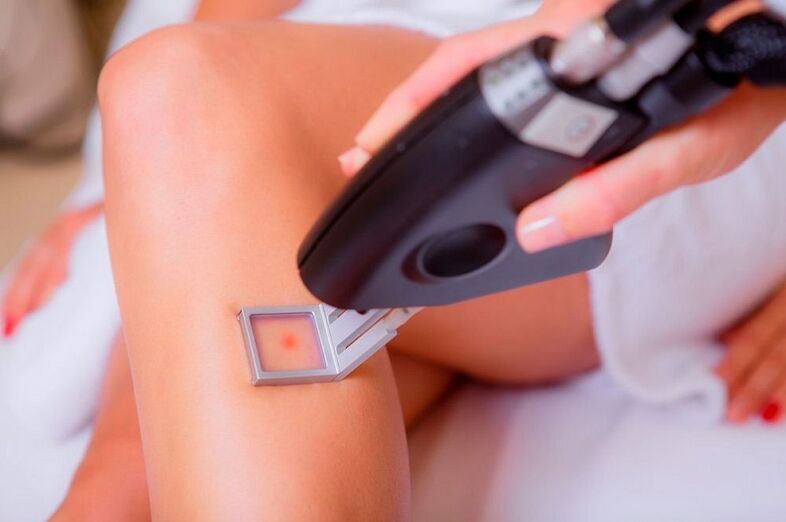Papilloma is a benign formation on the skin or mucous membranes caused by one of many viruses in the Papovaviridae family. Human papillomavirus or HPV is a generic name for a group of non-enveloped DNA viruses that spread in various ways. HPV infection can occur during sexual intercourse, with minor injuries to the mucous membranes and skin during childbirth (from the infected mother to the child).
Adult human papillomavirus

Human papillomavirus infection (PVI) is quite common. Many studies have shown that more than 80% of young people are carriers. After the infection enters the human body, it affects the squamous epithelium of the skin and can multiply in it for several years. Its various types affect the mucous membranes, leading to the appearance of benign formation of conjunctiva, oral cavity and genitals.
Female papilloma
Human papillomavirus infection also threatens men and women. However, certain types of pathogenic microorganisms pose a great threat to women's health and life. A large number of studies have shown that HPV can cause cervical cancer.
Maternal papillomavirus
The rapid weakening of the immune system and hormonal imbalance will stimulate the active reproduction and symptom performance of papillomavirus, which has been inactivated in the human body for a long time. During pregnancy, the appearance of papilloma on the skin and mucous membranes may scare the expectant mother. In this case, the woman needs to consult with a gynecologist urgently.
HPV is not a contraindication to conception, although there is a high possibility of infant infection during delivery.
Male papilloma
Male papilloma does not show clinical manifestations in most cases. But men are also the source of infection and infected their sexual partners. In the normal state of the immune system, the activity of pathogenic microorganisms is reduced to zero. However, due to immunodeficiency, the situation may change, and the papillomavirus in the blood will start to become active, and in some cases it will be actively expressed.
The type of sexually transmitted infection that causes genital warts affects both men and women equally. HPV 16 and 18 may cause cervical cancer in women, but it is rarely found in men. Once this papilloma virus enters the body, it will stay in the urethra for a period of time, and then disappear by itself due to the lack of an environment conducive to its reproduction. Male genital warts may appear:
- Most often on the coronal groove and frenulum of the penis;
- It rarely appears on the body or head of the penis;
- In the area of the external opening of the urethra;
- In the urethra itself;
- In the perianal area and the anal canal.
Compared with women, male papilloma rarely causes the development of cancer. Diagnosing HPV in men is also difficult.
Pediatric human papilloma

Papilloma in men and women, as well as papilloma in children, will affect all organs with epithelium or transitional epithelium. It can be the skin, oral mucosa, pharynx, and respiratory tract. The spread of human papillomavirus in childhood occurs:
- During the development of the fetus in utero;
- When the child passes through the mother's birth canal;
- Family approach from parent to baby;
- In the team (kindergarten, school, sports and development department).
However, even if a child is infected, the papillomavirus in the body can be eliminated by itself after a certain period of time. If this happens not immediately after the onset of puberty, in many cases, the papilloma on the body and mucous membranes will disappear.
Papilloma on the body
The most common in children is the clinical manifestations of human papilloma in the form of common or rough warts. They are usually located on the inside and back of the palm or knee area. However, papilloma often occurs, which has a prominent keratinized surface on any part of the body. They do not cause discomfort and do not cause pain. When injured, such formations may begin to get injured and bleed.
Papilloma on the laryngeal mucosa of children

If human papillomavirus is present in children, the most common diagnosis in children is laryngeal papillomatosis. If an infection occurs during childbirth and the infection is transmitted from mother to child, the external manifestations are usually observed before the baby is five years old. The cause of laryngeal papilloma is that HPV types 6 and 11 enter the child's body.
Infection method, PVI type and its manifestation
Papillomavirus is highly contagious. There are many ways of transmission, which greatly increases the number of people at risk. Modern medicine divides more than one hundred papilloma pathogens into various types, which are characterized by their own transmission routes, external manifestations and the degree of harm to health.
How human papilloma spreads
Papillomavirus infection can occur through sexual intercourse, domestic use, or during childbirth, where pathogenic microorganisms are passed from mother to child. A person may also be self-infected by a papillomavirus. For example, during hair removal, automatic vaccination may cause mechanical damage to the skin or mucous membranes.
Papilloma: the cause of infection through sexual intercourse
For papillomavirus infection, the cause may be different. But the most common one is sexual transmission. In addition, you will not only infect the vagina, but also infect the anus and even oral sex. There are about 40 types of papillomavirus, and the reason for their spread is frequent changes in partners and early onset of sexual behavior.
The spread of the virus in the country
The insidious thing about HPV is that it has a high possibility of spreading in the family. There are several factors that increase the risk of papillomavirus, and the reasons are different, such as:
- Cuts and scratches on the skin, as well as excessive dryness and cracks on the skin;
- Diseases that weaken the immune system (HIV infection, flu, herpes);
- Long-term use of powerful drugs that suppress the function of the immune system.
Infections in babies during childbirth
Like many genital infections, papillomavirus can be passed from mother to child during childbirth. In addition, babies may be infected before delivery. If a pregnant woman is a carrier of HPV 6, 11, 16, or 18, the pathogen most often affects the baby’s oral mucosa. These types of papilloma infection usually lead to the development of juvenile laryngeal papillomatosis.
Many women mistakenly believe that a Caesarean section helps prevent infections in their babies. But even in this case, the papillomavirus still has the possibility of transmission, and pathogenic microorganisms can be transmitted through the placenta.
How does the human papillomavirus behave

HPV is a type of virus. Under certain factors that cause its malignancy, it will cause the development of benign tumors in the body. By positioning, the papilloma can be cutaneous or genital. These tumors can show:
- Common warts are characterized by a dense, rough surface with additional growth. The size of this type of tumor starts at 1 mm. Usually, their appearance appears in the palms and fingers, knee area (mainly in children), but this type of papilloma can also be present on the body. The rapid decline in immunity promotes the spread of common warts.
- Plantar warts can cause special discomfort and pain. The cause of this type of tumor is several types of HPV: 1, 2, and 4. In appearance, the plantar structure can be confused with ordinary calluses. At first they were small in size. However, the papilloma will grow in the future, and other growths will appear around it.
- Flat warts appear when HPV types 3 and 10 are present in the human body. These tumors actually fuse with the skin and can be round or polygonal. Usually, their appearance is accompanied by itching, redness and soreness.
- Filament formation in virus carriers who have reached the age of fifty or over. This papilloma may appear on the eyelids, body, underarms, etc. Their length can sometimes reach 6 mm.
- Genital warts develop against the background of HPV 6 and 11. In women, such tumors can be located in the anus and rectal mucosa, vaginal wall, uterus and vulva, and groin area.
Types of papilloma

The main danger of male and female papillomaviruses is that they are considered carcinogens in modern medicine. About one-third of the more than one hundred existing variants affect the genitals of men and women and cause the development of genital warts.
Cancer risk classification
Unenveloped DNA viruses not only cause uncontrolled division of skin cells and mucous membranes, but also cause malignant tumors. However, not every papilloma will lead to the development of cancer. Various factors increase the likelihood of developing carcinogenic diseases:
- Early onset of sexual behavior, frequent changes of partners, and preference for anal sex;
- Whether there are sexually transmitted infections affecting male and female genitals;
- Smoking and alcohol abuse negatively affect the state of the immune system and stimulate the appearance of papilloma in intimate areas and other parts of the body;
- Use intrauterine contraceptive devices for contraception and long-term use of oral contraceptives;
- Endometriosis and other diseases of the female reproductive system organs.
Determining the type of papillomavirus will help make a complete diagnosis. The specific diagnosis is determined by the doctor.
Non-carcinogenic type of virus
Among the various types of HPV, there is a group of pathogenic microorganisms that do not cause special harm to health. Non-oncogenic HPV types include papillomaviruses of genotypes 1, 2, 3, and 5. Their presence in the body can cause various types of warts to appear on the skin.
- When infected with genotype 1 HPV, common and flat warts on the hands and feet appear.
- Genotype 2 virus causes a flat and vulgar appearance on the hands.
- HPV 3 causes uncontrolled division of skin cells and the formation of flat warts and juvenile warts.
Low carcinogenic risk virus
When HPV 6, 11, 42, 43 and 44 enter the human body, human papilloma with low carcinogenic risk will occur. The most common viruses are genotypes 6 and 11. They account for about 90% of all infections. These types of pathogenic microorganisms can cause a special type of genital papilloma-genital warts. Their location on the mucous membrane of the cervix or penis in men has a certain risk of malignant formation.
Papillomavirus has a high risk of cancer
HPV genotypes 16, 18, 31, 33, 35, 39, 45, 51, 52, 56, 58, 59, 66 and 68 have a high risk of cancer. More than 70% of infections are type 16 and 18 virus infections. Type 18 papilloma is often found in the diagnosis of adenocarcinoma. These types of pathogenic microorganisms cause the development of cervical cancer, anal cancer, vaginal cancer, vulvar cancer or male penile cancer.
Categorize viruses through localization of manifestations

The external manifestations of male and female papilloma can be observed on the skin of the open area of the body, the soles of the feet, and the skin and mucous membranes of the intimate area. The lesions may be localized. In people with severe immunodeficiency, multiple tumor foci are most often observed. After the virus enters the human body, three stages of its development can be noticed:
- During the incubation period, no clinical manifestations of infection were observed;
- Very few subclinical symptoms and morphological symptoms;
- The clinical stage means the appearance of papilloma, dysplasia and malignant tumors.
The characteristics of the external manifestations depend on the type of virus that infects the patient's body.
Papilloma on the neck
Papillomas on the necks of virus carriers may show up for life. This form is benign and will only cause psychological discomfort. Similarly, small tumors on thin legs may hang on clothes and cause injuries, causing pain and bleeding. If such problems occur, it is recommended to remove the papilloma in the neck.
Papilloma in an intimate place
Papilloma is called condyloma acuminata in intimate places. It can be located in women on the vaginal mucosa or cervix, or on the penis of men. Similarly, genital warts can develop on the anal tissues. All types of papillomavirus that infect the genitals can be divided into:
- Viruses with high carcinogenicity (HPV 16, 18, 31, 33, 35) can significantly increase the risk of tumor malignancy, but will not cause genital warts;
- Papillomaviruses (HPV 6, 11) with low levels of carcinogenicity can cause the formation of condyloma acuminata.
Papilloma on the eyelid

Papilloma of the eyelid is most common in the adult population of HPV carriers. They are usually located on the edge of the lower eyelid. The tumor can be in the form of cauliflower. The danger of such formations lies in their constant exposure to direct ultraviolet rays and the habit of rubbing their eyes with dirty hands. In the latter case, the risk of eyelid papilloma infection is significantly increased. The color of the tumor can be flesh-colored or dark.
Papilloma: treatment and diagnosis
Once the papillomavirus enters the body, it may behave differently. The human body's response depends on the type of virus itself, immune status, the presence of accompanying diseases, and other factors that are individually determined for each patient. Therefore, the behavior of papilloma virus in the human body mainly has the following three types:
- Pathogenic microorganisms enter the blood and act passively. In this case, people are carriers of the virus and can infect people with whom they are in close contact.
- The virus enters the human body, but does not integrate into the cell's chromosomes, but at the same time stimulates the uncontrolled division of skin and mucous membrane cells and the formation of papilloma and warts.
- HPV penetrates cells, changes their structure, and becomes the cause of malignant tumors.
In each case, specific diagnosis and treatment methods are needed to identify the virus.
Diagnosis of human papillomavirus
The main type of diagnosis is the external examination of the patient. It is important if the infection manifests as a papilloma on the external genitalia (genital warts). To determine if HPV and its type help is present in the laboratory, do the following:
- PCR method. Such tests are very sensitive to detecting infections in subclinical or latent developmental stages.
- Digene test. Hybridization analysis can detect 13 viruses with high carcinogenic potential and 5 viruses with low carcinogenic potential. Generally, in order to diagnose papillomavirus more accurately, the dual-gene detection is combined with cytological research.
In men, the diagnosis of papillomavirus is particularly difficult. Screening male patients is not relevant. In this case, diagnosis is only possible when there are external clinical manifestations of the disease.
Papilloma: how to get rid of external manifestations
If a person has papillomas on their body, the doctor will tell you how to get rid of them. It is not worth dealing with external manifestations alone, because it is full of health-damaging consequences, especially infections. It is necessary to remove papilloma for several reasons:
- Over time, certain types of papilloma will grow and become malignant;
- The presence of tumors brings psychological discomfort to patients;
- Papillomas on the body and private parts may hurt and bleed.
However, despite this, only a doctor can determine that papilloma needs to be removed. For this, you should contact a dermatologist or dermatologist.
Laser removal of papilloma

Laser papilloma resection is very effective. Its use allows you to quickly get rid of benign tumors. It only takes a few minutes to laser cut a formation with a diameter of about 5 mm. However, in some cases, it may be necessary to remove the papilloma in multiple stages. This procedure is performed using local anesthesia. The tissue removed by laser resection is not suitable for histology.
How to remove papilloma by radio wave method
Removal of radio waves is an absolute quick and easy way to get rid of papilloma. During the operation, the tumor is removed in its basal area. After removal, a small piece of dark crusty remains in place. The excised material is suitable for histological analysis. When deciding how to remove the papilloma without the risk of scarring, the radio wave method is the best choice for the patient.
Removal of papilloma with liquid nitrogen
When it comes to the external manifestations of papilloma and how to eliminate them, people cannot fail to mention the method of removing papilloma with liquid nitrogen, otherwise it is called cryoablation. This method of removing papilloma from the body is very effective, but there is still the possibility of recurrence of external symptoms. When performing this procedure, cold nitrogen will affect the papilloma cells, causing them to freeze. This method is characterized by less trauma and no pain.
Electrocoagulation
Electrocoagulation-the targeted effect of electric current discharge on tumor tissue to remove papilloma in the body. This method is very efficient (80-95%). Its main advantage is that there is no trace after removing the formation from the papilloma. Within a week, only a small piece of crusty remained on the skin, which disappeared after the expiration of that period. You can't tear it off by yourself.
medical treatement

Removal of papilloma with a laser or any other method recommended by a doctor is only a solution to external problems that cause aesthetic, psychological or physical discomfort. The method of tumor removal has nothing to do with anti-papillomavirus, and the treatment of papillomavirus requires a comprehensive approach.
Today, there is no specific drug for effectively eliminating papillomavirus and its external manifestations from the body. Today, the comprehensive treatment in medical practice is:
- Use laser, liquid nitrogen and other methods to remove benign tumors to remove papilloma;
- Immunotherapy designed to activate the natural protective function of the human body;
- Fully strengthen the body, take vitamin complexes, and maintain a healthy lifestyle.
By contacting your doctor and passing all necessary studies, you can confirm or deny the presence of papillomavirus in your body, learn how to remove the tumor and reduce the risk of its reappearance.
HPV and immunity
Once in the body, HPV may not show up for a long time. Papilloma on the eyelids, neck, body or proximal area is an external manifestation of viral activity, and immunity is drastically reduced. Therefore, the risk of papilloma on the neck, skin and mucous membranes of the entire body is significantly increased due to the following reasons:
- Transfer of infectious diseases or surgical intervention;
- Pregnancy and lactation;
- Constant stress, hypothermia and other factors that negatively affect immunity;
- Long-term use of certain drugs;
- The presence of reproductive tract infections.
Anything that weakens the immune system will cause the virus to multiply in the blood. Therefore, it is important not only to know how to remove papilloma, but also to know how to strengthen the immune system to prevent it from reappearing.
Papilloma: alternative treatment
If the papilloma appears on your body, it is strictly forbidden to remove it at home. In order to treat safely and effectively, you need to see a doctor. Experts will prescribe necessary research prescriptions and formulate a treatment plan based on the research results. According to this program, patients can treat papillomavirus at home under the supervision of a doctor.
Prevent HPV
Prevention of papillomavirus through folk and traditional methods is to reduce the risk of infection. It can also prevent the virus from multiplying in the body and the formation of external symptoms such as papilloma on the skin and mucous membranes, and the formation of external symptoms such as the neck, eyelids, palms, and soles of the feet.
Prevent human papillomavirus infection
Therefore, one day you do not have to face the problem of how to remove papilloma, you need to remember some of the main measures to prevent viral infection. Unfortunately, in an intimate relationship with a new sexual partner, the use of condoms and other contraceptives does not protect the human body from HPV infection. Only maintaining a monogamous relationship with a trusted partner can help reduce the risk of infection.
In order to prevent papillomavirus infection, traditional methods are not as effective as traditional methods. Modern scientists have developed several vaccines that can greatly reduce the risk of infection with HPV varieties with high carcinogenic potential (6, 11, 16, and 18).
The most suitable age for vaccination is 10 to 25 years old. The calculated impact is approximately 6. 5 years.
Prevent HPV manifestations

In order to prevent the activity of papillomavirus, replacement therapy is effective through formulas that strengthen the immune system. But before using them, you need to consult a doctor. Likewise, don’t forget the most effective and safest way to enhance the body’s natural protective functions through exercise, healthy eating and exercise.
Everyone can prevent papillomavirus at home. Take care of your health and don't forget to see a doctor regularly to prevent problems before they happen, and strengthen your immunity.























